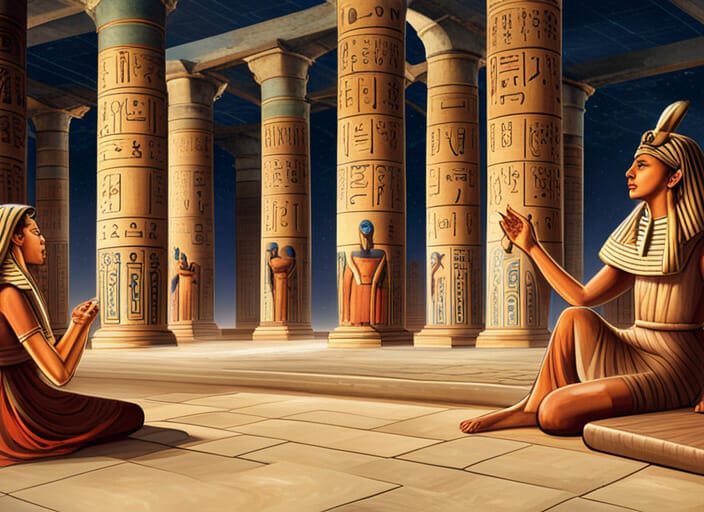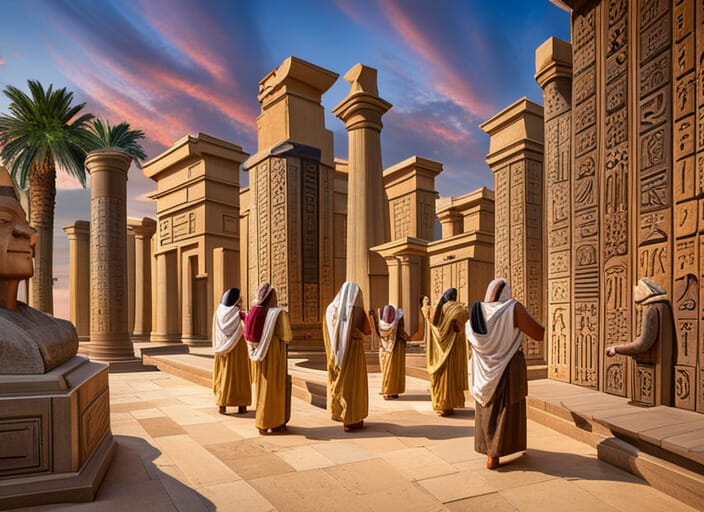Ancient Egyptian Sound Healing
Sound has the power to heal, to soothe, and to transform. As the ancient Egyptians believed, ‘Music is the medicine of the mind.’
In the rich tapestry of ancient Egyptian culture, sound played a vital role in their daily lives, from religious rituals to healing practices. Ancient Egyptian sound healing was a sophisticated system that utilized a variety of musical instruments, chanting, and vocalization to restore balance and harmony to the body, mind, and spirit.
In this article, we will explore the fascinating world of ancient Egyptian sound healing, delving into its importance in their culture, the musical instruments used, the role of chanting and vocalization, and the techniques and practices employed.
We will also delve into the ancient Egyptians’ beliefs regarding the healing power of sound and how these beliefs have influenced modern applications and adaptations of their sound healing techniques.
Join us on this journey through time as we uncover the secrets and wisdom of ancient Egyptian sound healing, and discover how its profound impact can still be felt today.
Key Takeaways
- Sound was a powerful tool for healing and connecting with the divine in ancient Egyptian culture.
- Instruments like sistrums, harps, lutes, and flutes produced specific frequencies for different parts of the body.
- Chanting and vocalization harmonized the body and mind and stimulated healing.
– Ancient Egyptian sound healing aimed to restore harmony to the body, mind, and spirit.
The Importance of Sound in Ancient Egyptian Culture

Imagine yourself in ancient Egypt, where sound wasn’t just background noise, but a powerful tool used for healing and connecting with the divine. Historical evidence reveals the importance of sound in their culture. Similar to other ancient healing practices like Ayurveda and Traditional Chinese Medicine, the Egyptians believed that sound could restore balance and harmony within the body. They used techniques like chanting, drumming, and playing musical instruments to generate specific frequencies and vibrations with healing properties. These practices extended beyond physical healing to emotional and spiritual well-being. The Egyptians recognized the profound impact of sound on the body and mind, harnessing its power for healing and transformation.
Transitioning into the subsequent section about musical instruments used in ancient Egyptian sound healing, these instruments played a crucial role in their therapeutic practices.
Musical Instruments Used in Ancient Egyptian Sound Healing

Utilizing a variety of unique instruments, the ancient Egyptians harnessed the power of harmonious vibrations to promote well-being and balance. Resonance therapy, a form of sound healing, played a crucial role in their culture. The Egyptians believed that sound had the ability to connect the physical and spiritual realms, allowing for healing and transformation. Musical instruments were specifically designed to produce specific frequencies that resonated with different parts of the body.
In ancient Egyptian sound healing, a wide range of musical instruments were used. These instruments included the sistrum, a handheld rattle with metal discs that created a pleasing jingling sound. The harp, with its delicate strings, produced melodic tones that were believed to restore harmony within the body. The flute, made from reeds or bone, emitted soothing and calming sounds. The lyre, a stringed instrument similar to a small harp, produced resonant vibrations that were thought to balance the energies within the body.
By employing these ancient Egyptian musical instruments, sound healers aimed to restore harmony and promote well-being. The vibrations emitted by these instruments were believed to have a direct impact on the body, mind, and spirit. The use of resonance therapy in ancient Egypt highlights the deep understanding and appreciation the Egyptians had for the power of sound in promoting holistic healing.
Transitioning into the next section about ‘the role of chanting and vocalization in sound therapy,’ chanting and vocalization were also integral components of ancient Egyptian sound healing.
The Role of Chanting and Vocalization in Sound Therapy

To fully experience the benefits of sound therapy, you can incorporate chanting and vocalization into your practice. Studies have shown that vocalization can reduce stress levels by up to 30%. Chanting, a form of vocalization, has been used for centuries in various cultures as a powerful tool for healing. In ancient Egyptian sound healing, chanting was considered essential for harmonizing the body and mind. It was believed that specific sounds and vibrations produced through chanting could restore balance and promote overall well-being.
Chanting benefits include enhancing concentration, inducing relaxation, and even improving cognitive function. Vocalization techniques used in sound therapy involve using specific sounds, tones, and rhythms to stimulate different parts of the body. These techniques aim to activate energy centers, release blockages, and promote healing.
Transitioning into the subsequent section about techniques and practices of ancient Egyptian sound healing, exploring the rich history and methods of this ancient practice can provide valuable insights into its lasting impact.
Techniques and Practices of Ancient Egyptian Sound Healing

The techniques and practices of ancient Egyptian sound healing transport you to a world where vibrations and rhythms harmonize the body and mind. This ancient healing tradition involved the use of crystals and a deep connection with the divine. In ancient Egypt, crystals were believed to possess powerful energy that could be harnessed for healing purposes. They were placed on specific parts of the body or used to create musical instruments, such as crystal bowls or harps, to produce specific frequencies and vibrations. These vibrations were believed to restore balance and harmony to the body, mind, and spirit. Additionally, ancient Egyptians believed that sound had the ability to connect them with the divine and access higher states of consciousness. Through the use of chanting, vocalization, and the manipulation of sound frequencies, practitioners aimed to achieve spiritual enlightenment and healing. Transitioning to the subsequent section, the healing power of sound in ancient Egyptian beliefs was deeply intertwined with their understanding of the divine.
The Healing Power of Sound in Ancient Egyptian Beliefs

Sound played a crucial role in the ancient Egyptian belief system, connecting individuals to the divine and facilitating spiritual enlightenment and healing through the harmonization of vibrations and frequencies. The use of sacred frequencies was believed to evoke specific emotions, stimulate the chakras, and balance the energy centers of the body.
This ancient civilization recognized the profound connection between sound and spirituality, understanding that certain tones and melodies had the power to induce altered states of consciousness and access higher realms of existence. The Egyptians employed various sound healing practices, including vocal toning, chanting, and the use of musical instruments such as harps and flutes.
This holistic approach to sound healing aimed to restore harmony and balance to the body, mind, and spirit. These ancient techniques continue to inspire modern applications and adaptations of Egyptian sound healing, bridging the gap between ancient wisdom and contemporary wellness practices.
Modern Applications and Adaptations of Ancient Egyptian Sound Healing Techniques

Modern applications and adaptations of ancient Egyptian sound healing techniques continue to inspire and influence contemporary wellness practices, bridging the gap between ancient wisdom and modern approaches to holistic healing.
Modern research has explored the therapeutic benefits of sound healing, shedding light on the mechanisms through which it promotes healing and well-being. Studies have shown that certain sound frequencies can stimulate the release of endorphins, reduce stress hormones, and enhance the immune system. Additionally, sound therapy has been found to improve sleep quality, reduce anxiety and depression, and alleviate chronic pain.
These findings have led to the integration of sound healing into various healthcare settings, including hospitals, rehabilitation centers, and mental health facilities. Moreover, the adaptability of sound healing techniques allows for their incorporation into complementary therapies such as meditation, yoga, and massage, enhancing their overall effectiveness.
By embracing and refining ancient Egyptian sound healing practices, contemporary wellness approaches are unlocking new avenues for healing and self-discovery.
Frequently Asked Questions
How did ancient Egyptians incorporate sound healing into their daily lives?
Ancient Egyptians incorporated sound healing into their daily lives through the use of various musical instruments, such as the sistrum and the harp, which played a vital role in their spiritual practices. Sound was believed to have the power to heal and restore balance to the body and mind.
Were there any specific rituals or ceremonies associated with ancient Egyptian sound healing?
Ancient Egyptian sound healing rituals and ceremonies were an integral part of their daily lives. These practices involved the use of specific sound frequencies, instruments, and chanting to restore balance and harmony to the body, mind, and soul.
What evidence exists to support the effectiveness of ancient Egyptian sound healing techniques?
To support the effectiveness of sound healing techniques, evidence from scientific studies and anecdotal reports can be found. This includes improvements in physical and mental health, reduction of stress and anxiety, and positive changes in brainwave activity.
Are there any ancient Egyptian sound healing practices that are still used today?
Modern applications of sound healing include techniques such as binaural beats and sound therapy. Scientific research has shown that these practices can be effective in reducing stress, promoting relaxation, and improving overall well-being.
How did ancient Egyptians believe sound healing could affect physical and mental well-being?
Ancient Egyptians believed that sound healing could positively impact physical and mental well-being. They incorporated sound healing into their daily lives through rituals and ceremonies. Modern sound healing practices show evidence of effectiveness in promoting overall wellness.
Conclusion
In conclusion, the ancient Egyptians possessed a profound understanding of the healing power of sound. They harnessed the therapeutic benefits of sound therapy through the use of musical instruments, chanting, and vocalization. Their techniques and practices, rooted in their deep religious beliefs, aimed to restore balance and harmony to the body, mind, and spirit.
While ancient Egyptian sound healing may have evolved and adapted over time, its fundamental principles continue to inspire modern applications in the field of holistic medicine. The captivating world of ancient Egyptian sound healing awaits those seeking a profound and transformative healing experience.





